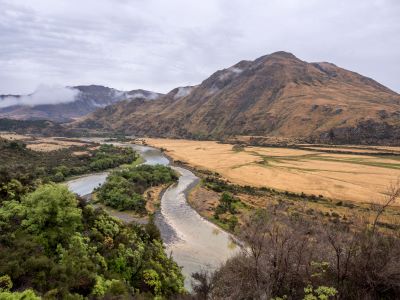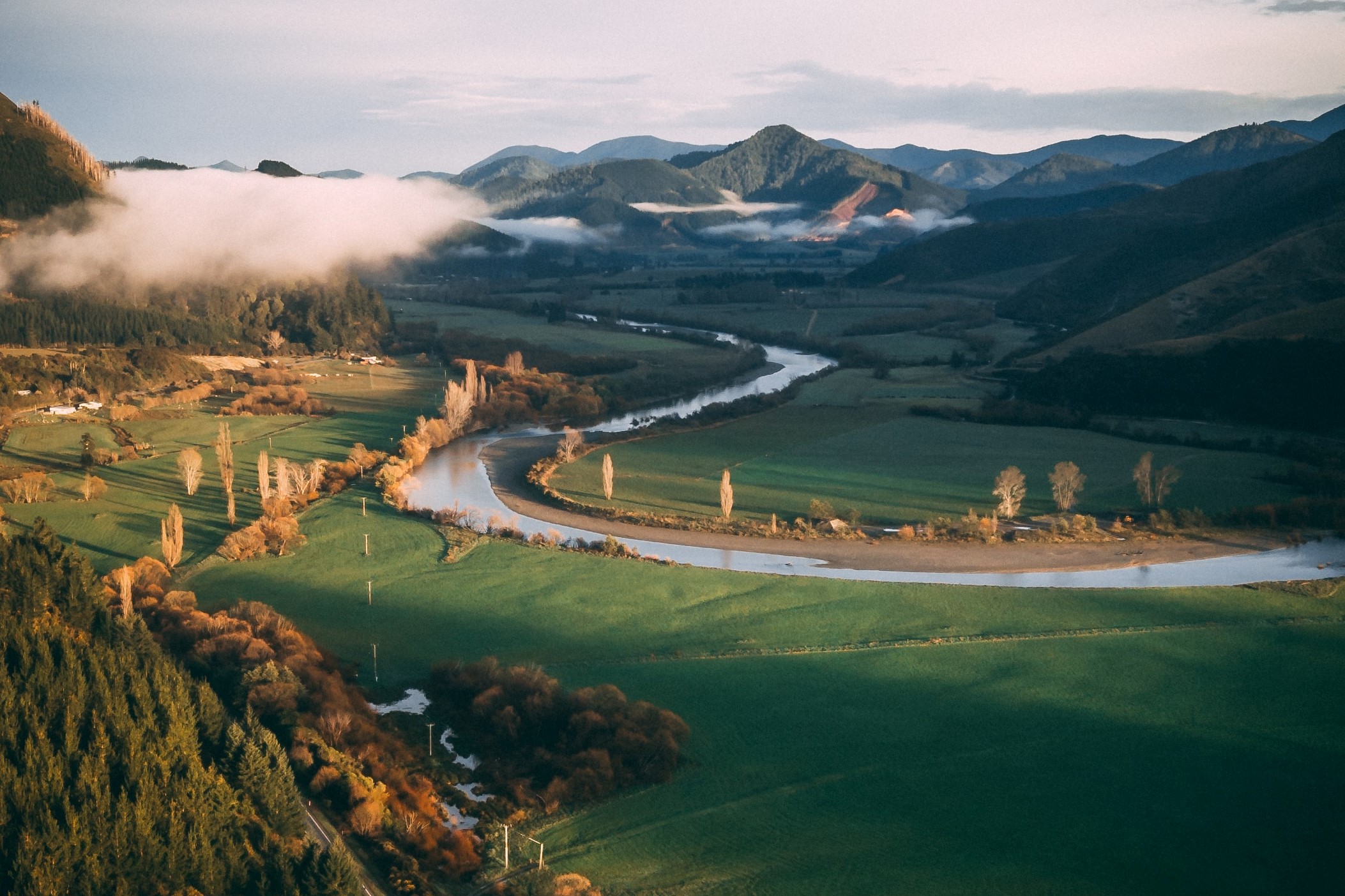New Zealand has over 70 major river systems, and countless more streams and tributaries. The majority of which hold trout. Finding the best rivers to fish can take a considerable amount of time. Something not always available for visiting anglers.
In this guide, I will discuss 11 of the rivers in New Zealand which offer excellent trout fishing.
These rivers are also large enough, or the trout cunning enough to handle a large amount of fishing pressure which allows them to fish well throughout the season.
Motueka River
The Motueka River is renowned for its dry fly fishing. Located in the Nelson region it is blessed with some of the highest hours of sunlight in the country.
This cool, usually clear river flows over a bouldery and stony bed. The Motueka has a very high population of resident and sea-run brown trout.
The middle and upper reaches offer excellent fly fishing for sighted and raising brown trout.
The lower reaches hold some good sea run trout but wading can be difficult. The middle and upper reaches offer easy wading, especially in low summer conditions. The headwaters are remote, hold few fish and are technically challenging.
The average trout is not large, with most caught between 2-5lb in weight. As is the case in many South Island rivers, the further upstream you fish the larger the trout become.
The three main tributaries, the Motupiko, Wangapeka, and Baton hold reasonable numbers of good size trout. These are best fished before Christmas. They become very skinny over the summer months and the trout drop back to deeper water in the main river.
There is good road access with many clearly marked access points. Arrive early to get your first choice. I personally will avoid fishing it over long weekends and the summer holidays.
Karamea River

The Karamea river, is the jewel of the Kahurangi National Park. For most of its length, the Karamea flows through the National Park. It offers some outstanding wilderness fishing.
The best fishing is in the upper reaches. Located many miles from the nearest road and most fishermen use helicopters to access it.
For a fan of wilderness style fishing, this is close to paradise. The only noise breaking the tranquillity is the buzz of sandflies and the drone of helicopters flying overhead.
For such a remote fishery, it is surprisingly busy and it requires quite a bit of luck to get the roaring lion hut to yourself.
The lower river, flows through farmland near Karamea township. Surprisingly this portion of the river holds a low number of fish. During the whitebait season, Sea run brown trout are often caught near the mouth and there is always a chance of a double digit trout.
There are two main ways to access the Karamea. The most popular is by helicopter, most drop anglers off near the roaring lion hut where they base themselves for several days of fishing.
The second option, and my preference, is the two-day hike over the stunningly beautiful Mount Arthur tableland.
Finally, it is possible to hike 5-8 hours to the rarely visited Grey’s hut. Do not take this track lightly, it’s overgrown and can be challenging. I spent an uncomfortable night camping on a boulder when I run out of daylight. The fishing around Greys Hut, in my experience, is not worth the difficulty of the hike in. But the river is beautiful.
La Fontaine Stream
This spring creek offers some of the best dry fly fishing in New Zealand. The water is deep, cold, and usually lightly stained. Under overcast conditions spotting trout, between the weed mats can be challenging.
The best time to fish La Fontaine is during a hatch, during which many trout will rise to the surface. At other times the trout hold deep between and under the weed mats making them difficult to target.
The resident brown trout thrive and are generally in good condition. The La Fontaine is rather short, around 16km in length. It begins in the foothills of surrounding ranges and joins the Wanganui river several miles upstream of the sea.
On my first visit to the La Fontaine, I was blessed with perfect spotting conditions, blue skies, high sun, and no wind. In the 150m I strolled I counted no fewer than 15 well-conditioned brown trout. Unfortunately, not a single fish was rising that day.
Maruia River
No list of the top trout fishing rivers in the south Island will be complete without a river in the internationally renowned Murchison district.
The large Buller river dominates the valley, but many of its tributaries offer better fishing. This is a very popular fly fishing destination, and the quality of the fishing in some of the smaller streams suffers because of the high numbers of anglers.
The Maruia is a medium size river, which holds a healthy population of brown trout and some rainbows. This river holds a lot of trout, including large shoals of juvenile brown trout. With so many eyes, casting anywhere near the large groups of juveniles can see them scatter in all directions. This can make it challenging casting to larger fish feeding nearby.
The Maruria is a river split into two halves. Above and below the falls. Downstream of the falls, the Mauri is deeper, slower and more popular for spin fishing.
Upstream of the falls the Mauria is wadable and offers some excellent fly fishing.
For adventurous anglers, the Mauria Gorge offers some unforgettable fishing.
A word of warning. The gorge is long, some anglers take two days to fish it. Others find themselves caught short of time, forcing them to travel fast to avoid the approaching darkness.
Jackson River
The Jackson has to be one of the most picturesque rivers I have had the pleasure to fish. The freestone riverbed is dominated by colourful rocks and crystal clear water. All surrounded, by thick, untouched native forests.
While trout numbers do not seem to be high. They are easy to spot and the remote location means fishing pressure is not high.
The Jackson is around 24km in length, begins in the Olivine Range, and joins the much larger Arawhata River quite close to the sea. The large Arawhata River itself undoubtedly holds some good trout, but access is extremely difficult without a jetboat or helicopter.
Lake Ellery and its outlet stream are also worth a visit. Although shore access and casting is very limited. I normally launch a fishing kayak at the road bridge and paddle upstream.
Like all west coast rivers, remember your insect repellent because the sandflies are relentless.
Mataura River
The Mataura might just be New Zealand’s most famous trout river. It offers over 150km of fishable water, and some of the most consistent mayfly hatches in the country. Trout raise throughout the day. The evening rises over the warm summer months can be spectacular.
This is a long river, and the fishing differs throughout its length. The headwaters, are less commonly fished but offer excellent sight fishing over a shingle bed.
This section is made up of a series of ripples, long runs, and pools. The average trout weighs between 1-5lbs.
The middle section of the river is the most famous. The dry fly fishing here is legendary. The river is larger, flowing through farmland. The grassy banks are at times covered with groves of willows.
In the summer months, the trout here can become hypnotized while feeding on willow grubs. The trout in this section are very numerous although slightly smaller in size.
The lower river is often overlooked by anglers. There the river is wide and slow but is home to some of the river’s largest fish.
On average, this section is around 75m across and shoreline access can be difficult. Night fishing black wooly buggers can produce trout of trophy proportions. It is also an excellent river for trolling behind a kayak.

Oreti River
The Oreti is best known for the size of its trout, in the lower reaches large searun trout chase smelt and whitebait. Trout exceeding 10lb are caught with some regularity. The lower river is in sharp contrast with the headwater where the trout are few in number but large in size.
The upper river flows through golden tussock grasslands. The river is a mixture of deep pools, long runs and contains a low number but typically large fish. Expect to walk long distances between fish.
This is a traditional sight fishing country, the trout are too few and far between to make blind fishing productive. There is not much riverside vegetation cover to hide behind, so careful stalking is required when approaching fish. Trout of over 10lb can be caught.
The middle river is a stereotypical New Zealand trout river flowing mostly through farmland. Long ripples and deep pools hold a decent number of average size fish.
This section of river is popular for both fly and spin fishermen. It is worth fishing late in the season when the upper portion can be under intense angler pressure.
The lower section of the river provides excellent fishing, especially during the spring when trout are feeding upon whitebait. Most anglers choose to fish streamers or use a spinning rod. Excellent water for trolling behind a small dinghy or kayak,
Nevis River
The Nevis is a popular destination for anglers staying in Queenstown. The river flows through high tussock grasslands, the water cold, even in the warm summer months. The backdrop of the remarkable mountains makes for a very beautiful backdrop.
This is a very popular river, so best fished early in the season. By late season the trout become wary and increasingly line shy. Long tippets, and precise presentation is required for any chance of success.
Late in the season, many trout also drop downstream in search of deeper water.
On average trout numbers are low, but the average size more than makes up for it. The further up the river one fishes, the larger on average the trout become.
In the very upper tributaries, small Brook trout can be caught. They are rarely fished for.
Tekapo Canals
Depending on who you ask, the Canals offer some of the best or worst trout fishing in New Zealand.
Several world record trout have been caught here, and more likely still lurk in the cold depths.
The swift and cold hydroelectrical canals contain populations of wild brown, rainbow trout, and salmon. There is also several salmon farms where fish occasionally escape from.
The trout grow large, often obese, thanks to the cold, clean water and the plentiful easy food in the tailwaters downstream of the hydroelectric dams, and by scavenging fish pellets that drift from the salmon farm.
While the trout are wild, they grow to their large mainly thanks to the artificial salmon pellets which they scavenge. When fishing the canals, a 20lb trout is only a matter of time.
The best aspect of the canals is that it keeps many of the catch and keep anglers away from the wild rivers. I personally, have no desire to fish there but for advice, I suggest checking this guide.
Hurunui River

The upper Hurunui offers excellent fishing for sighted brown trout. This is a big country and exposed to the elements. In the headwaters, each branch offers about a day of fishing for large trout. Expect to walk a lot because the trout are not common.
Downstream from Lake Sumner outlet is some of the most productive brown trout fishing in the country. Although steep sides and encroaching vegetation can make casting difficult and wading is not always possible.
Gorges throughout much of the Hurunui make it difficult, if not impossible, to fish.
The lower Hurunui is a braided river, which holds good populations of trout in deep pools. Most anglers target salmon, so the trout see relatively light fishing pressure.
Goulter River

Update: A large flood in the winter of 2021 did a lot of damage, trout populations will likely take several years to recover.
The Goulter River use to be an amazing fishery. Holding a healthy population of large brown trout. The Goulter is a medium size river that flows through the bushy Mountain Richmond Forest Park. The river, largely spring fed runs clear and cool making it a perfect habitat for brown trout.
The Goulter offers about a days worth of fishing from the Carpark, to the start of the gorge at the mid Goulter hut. There are a few trout in the upper gorge but the going becomes rougher.
Large trout still inhabit many of the pools but numbers have been on the decline. The resident trout are cunning and quick to spook. To have any chance of success, long tippets and accurate casts are essential. If there are already anglers on the river, the fishing is going to be extremely challenging, I personally would drop back and fish the less renowned lower gorge instead.
Access: Most anglers drive up the North Bank road and then follow the hiking track from the car park. The last few miles of the road require 4WD. In lower summer flows, it is possible to wade across the Wairau to reach the mouth of the Goulter but the lower river is not usually worth the effort.

